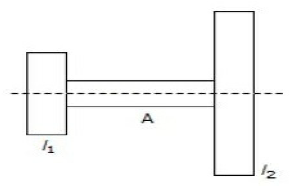Theory of Machines MCQ Question with Answer
Theory of Machines MCQ with detailed explanation for interview, entrance and competitive exams. Explanation are given for understanding.
Download Theory of Machines MCQ Question Answer PDF
Question No : 43
In a differential band brake as shown in the below figure, if the length OB is greater than OA, then the force P at C should act in the downward direction. 
Question No : 44
In the two rotor system as shown in the below figure (I₁ < I₂), a node of vibration is situated 
Question No : 45
Maximum fluctuation of energy in a flywheel is equal to [where I = Mass moment of inertia of the flywheel, E = Maximum fluctuation of energy, CS = Coefficient of fluctuation of speed, and ω = Mean angular speed = (ω₁ + ω₂)/2]
Question No : 46
A rigid body, under the action of external forces, can be replaced by two masses placed at a fixed distance apart. The two masses form an equivalent dynamical system, if
Question No : 47
Hammer blow
Question No : 48
The secondary unbalanced force due to inertia of reciprocating parts in a reciprocating engine is given by (where m = Mass of reciprocating parts, ω = Angular speed of crank, r = Radius of crank, θ = Angle of inclination of crank with the line of stroke, and n = Ratio of the length of connecting rod to radius of crank)
Question No : 49
The type of pair formed by two elements which are so connected that one is constrained to turn or revolve about a fixed axis of another element is known as